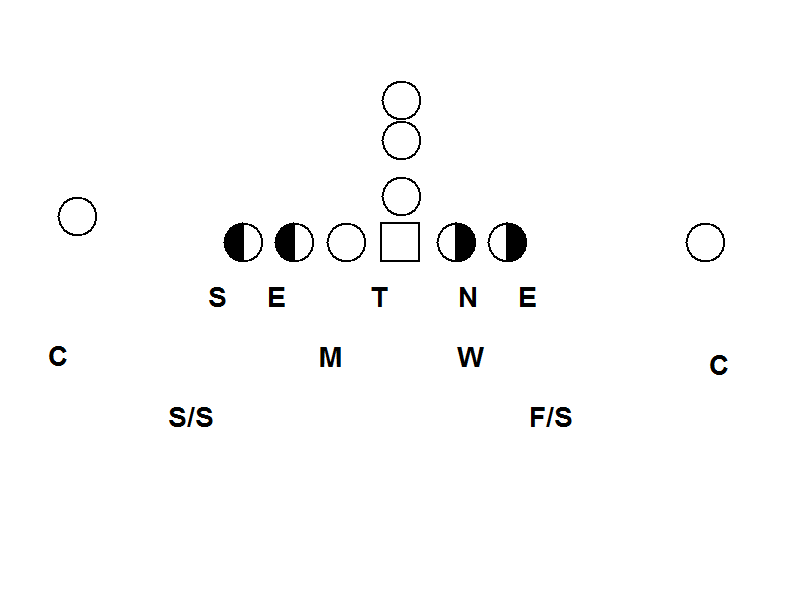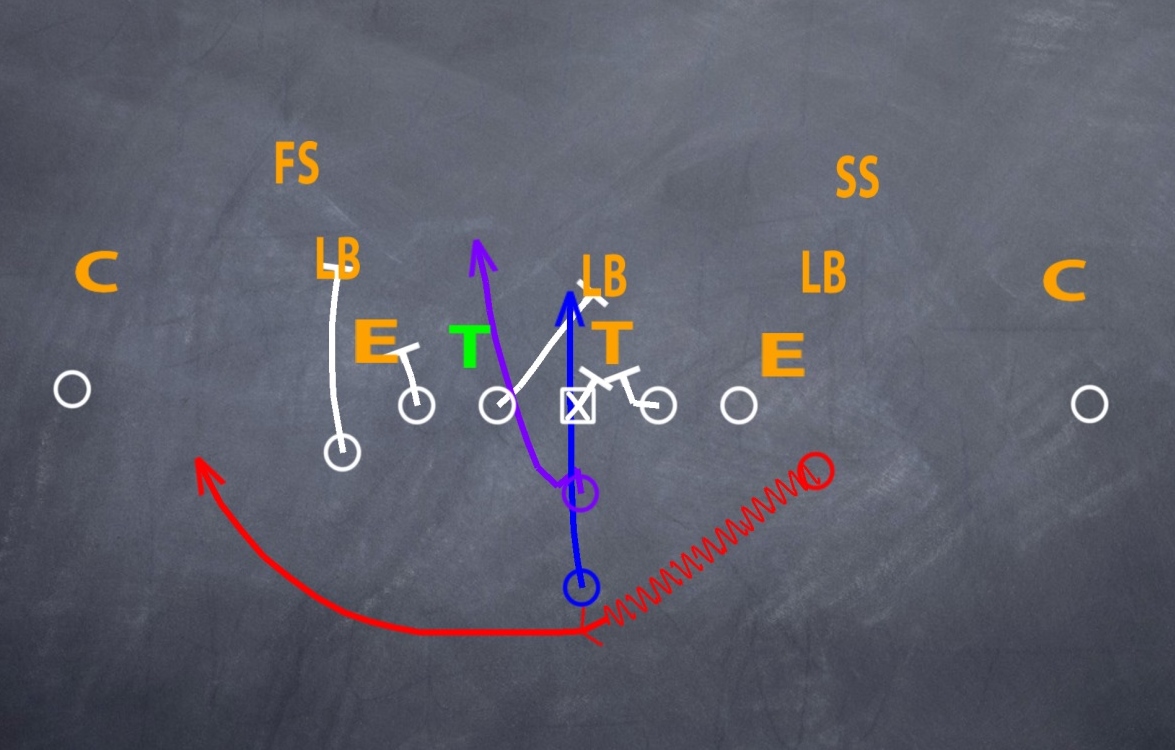The 4-3 defense has proven to be very versatile. We have dealt with a lot of changes in offensive attacks recently and have been able to deal with the explosion of spread offenses. At the same time, the 4-3 defense has handled the return of the single wing and double wing attacks.
While the base defensive rules will help your front and coverage adjust to just about anything, we can make the defense even better. When you know what you will be seeing, you should prepare more than one way to handle it.
Our game plan will always include multiple ways to attack what the opponent does best. The magic number for us is 3.
Against a zone read team, we want 3 ways to defend it. We’ll carry 3 variations of zone blitzes for a drop back passing team. And for teams that run trips formations, we will always have 3 different looks to give them.
The 3 looks that we use will not always be the same, but there are 3 zone coverage looks we can give teams who are aligning in trips formations on a large percentage of downs.
The Survivor Check
Our base coverage check is ‘Survivor’. This is a part of our quarters coverage package, and is the third check we install during the season (after ‘Read’ and ‘Alert’).
When we are in our base quarters call and the offense aligns in a trips open formation, the trips side safety will call an ‘Alert Check.’ He always calls Alert when he has two receivers to his side. For the 3rd receiver on his side, he echoes a ‘Survivor’ check across the field to the opposite safety, who echoes the call to the single receiver corner.

Survivor locks the backside corner on the single receiver in man coverage. We give him the option of playing press coverage or off man, but he will always play with inside leverage. The Will linebacker has man coverage on any #2 receiver (the running back) releasing to his side.
On the Alert side, the corner, strong safety and Sam are playing their normal alert rules:
- Corner: Key #2 receiver. If #2 releases in or vertical, lock on #1. If #2 releases out, stay over #1 until the receivers cross (vertical line rule) then pass off #1 to the safety and lock on #2.
- Safety: Key #2 receiver. If #2 releases in or vertical, lock on #2. If #2 releases out, stay over top and take eyes to #1. When receivers cross (vertical line rule) pass off #2 to the corner and lock on #1.
- Outside linebacker: Key the backfield. On pass read, drop on #2 receiver to #3 receiver. Wall #2 on inside breaking routes.
The Mike and free safety in the Survivor Check are now responsible for the #3 Receiver.
- Mike: Key the backfield. On pass read, drop on #3 receiver. Wall #3 on inside breaking routes and force him to go over top of you.
- Safety: Key end man on the line of scrimmage for run/pass key. On run, you are the force player on the weak side. On pass, get over top of #3 receiver.
While all of this may seem complicated at first, it is our base coverage check for the trips side corner, safety and outside linebacker. The Mike linebacker is always a drop on #3 player in quarters. Only the single receiver side safety and corner change.
The free safety should have no problem getting over top of #3 because most of the deeper routes we are concerned with be coming all the way across the field. 4 vertical concepts from trips will bring the #3 receiver across to the opposite hash.
We do work on passing off deep scissors routes by the #2 and #3 receivers between the safeties. This is not easy but comes with work, experience, and communication between your defenders.
Cover 2 Zone Coverage
There are times when we do not want to take our eyes off the quarterback. We also may want to give more help to the single receiver side. It is not uncommon for teams to try to isolate a 1-on-1 match-up on the single receiver side in Survivor.
To accomplish these goals, we can use cover 2. This is primarily a passing coverage for us, though man teams use cover 2 as an every down coverage with their 4-3 Defense.
If you are going to use this coverage as an every down coverage, your corners become your force players. In that situation, work them in an outside leverage press technique as much as possible.
For our defense, we use cover 2 in passing situations. We play from outside leverage, 5 yards off the #1 receiver with our corners the majority of the time. In either situation, the corners cannot give up an easy outside release. They need to funnel the receivers into the deep 1/2 safeties.
Likewise, the outside linebackers need to wall any inside breaking routes by the #2 receiver, funneling him to the deep 1/2 safety as well.
The Mike linebacker will deepen his drop to ensure that he walls any route by #3 that attacks the hole in the middle of the field. This is not a true Tampa 2 drop, just enough to let the safeties get over the top of his release.
The corners will release #1 after disrupting his route and drop off to the top of the numbers at 12-14 yards deep. The outside linebackers are dropping to the hashes and the Mike drops to the low hole.
Since we do not play a lot of Cover 2, we teach this as a spot drop.
Special Coverage
“Special” in itself does not have any specific meaning in our defense. Our ‘Special’ call may change from week to week or season to season. It is intended to deal with a particular problem.
This version of ‘Special’ can accomplish two tasks. We can lock down their best receiver with our top cover corner in man coverage, allowing everyone else to play a zone coverage.
We also are able to keep 7 defenders in the box, while still playing a zone coverage. The 4 under, 2 deep zone is similar to what we would play with a 2-deep zone blitz.
Our corner is locked on the #1 receiver on the trips side. We roll the strong safety down to play the flats and become the force player on that side. This lets the Sam linebacker walk back into the box.
The Will linebacker will align as wide has he needs to in order to be able to help on a quick throw to the single receiver in the flats. He is the force player on the weak side.
The corner on that side is playing a deep zone technique. His initial alignment is 2 yards inside, and 7 yards off of the single receiver.
Disguising Coverages
Having multiple answers for trips formations is not enough against some teams. Very smart quarterbacks and offensive coordinators will still find weaknesses – and every coverage has weaknesses!
The key is to make your weaknesses hard to find. That means disguising your coverages.
Many coaches make disguises too complicated. This is not a mystical concept. It is as simple as telling your defenders, “Never look like what it is.”
That is a hard concept for coaches who want their defense to look like it does in the playbook before every snap. If your players understand their jobs, and understand leverage, they should be able to disguise coverages until late in the quarterback’s cadence without any problem. It can cause us to panic because we think a kid doesn’t know the call. Learn to trust your players and have confidence in their ability to apply what you have taught them to the field!



